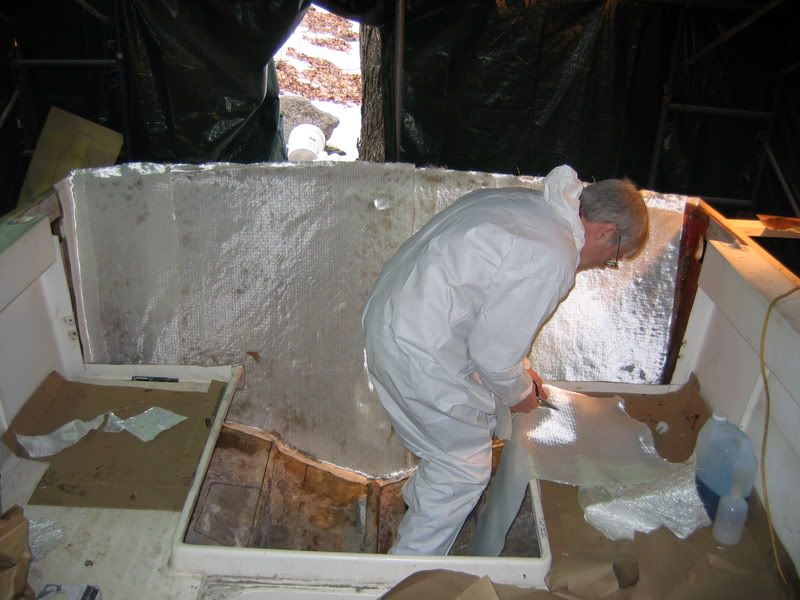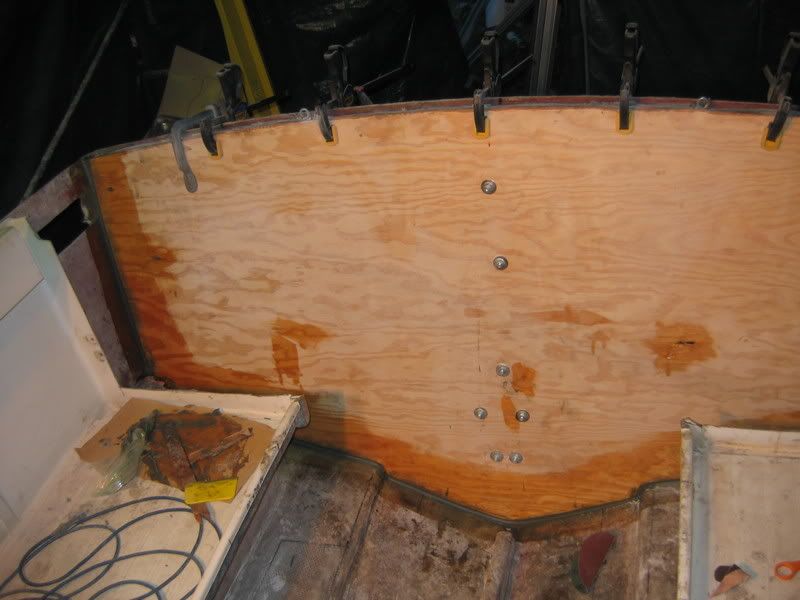
 |
|
|
|
#1
|
|||
|
|||
|
im starting my transom this week and was wondering after i got my plywood cut and ready to go in how do i make it stick and bond to the skin on the back. do i just use fiberglass? or should i use 404 or something
__________________
My goal in life is to restore as many classic seacrafts as i can. |
|
#2
|
|||
|
|||
|
Are you replacing from the inside? Search the old posts and you will find many techniques, all seemingly successful. Some people put a layer of mat down first, some don't, but everyone uses some form of thickened resin, be it epoxy or polyester. I used polyester, thickened with mostly milled fibers, often called "cabosil."
You can spread it with a notched trowel, then use lumber and thru bolts or some kind of clamps or something to provide the pressure to hold it all together until cured. Just remember, nothing seems to go as easily as planned, but even an idiot like me can make a transom that's strong as heck. |
|
#3
|
|||
|
|||
|
im doing the transom from the in side i hrar doing it from the out weakins the boat. whats better for old boat epoxy or polyester
__________________
My goal in life is to restore as many classic seacrafts as i can. |
|
#4
|
|||
|
|||
|
haha seems like an age old dilema...which is better....
The whole boat was built with polyester, and most modern boats still are. Pros will use polyester. Lots of people on here like epoxy, better secondary bond and lower smell. However, epoxy will not wet out glass as good as polyester, will not dissolve the binders in mat, and is more expensive. For me, the dollars will add up fast enough anyways, so cheaper is better. Just use a laminating polyester, and be done with it. If you are a novice (and we all are), it is easier to mix...if your mix isn't perfect, it will just affect curing time. If your off with epoxy, it won't kick! |
|
#5
|
|||
|
|||
|
I am of the opinion that cutting the outside skin, which is easiest, should be a last resort.
As for epoxy vs poly, versus vinylester? I like vinylester. But whatever you get, make sure the fiber has the surface coating ("sizing")for the resin you use. Fibers not sticking to resin is like glass in peanut butter. Vinylyester is a step between poly and epoxy, so it might be most flexible for fiber selection, and not too stinky. Or so I learned in composites class. Quote:
|
|
#6
|
|||
|
|||
|
I did the transom on my Tsunami from the inside.A lot more work,but imo it's a better way structurely,as you are not compromising the hull by cutting out the back.
After I had the core removed to the inner skin,I ground the surface with 36 grit on the disc sander and then applied one layer of 1708 with no-wax polyester resin to the face of the skin. The next day I applied a coat of polyester hull & deck putty(mix of resin,milled fiber,cabosil) with a notched trowel to the face of the skin,and also to the face of the transom. We then placed the transom in against the skin and clamped and temporarily thru bolted it until we had a good even pressure pulling it all tight together. We did this in the winter with temps around 35 degrees,which actually worked out great,as we had loads of time to work with it before the mixture started to kick.Once it was done we buttoned up the enclousure and brought the heat back up to 70 deg.,and let it cure. We clamped the the top edge with deep c-clamp,and so as not to affect the outer skin,we used the holes where the transom eyes were,and the outdrive hole was to put the bolts through.We only had to drill two other holes. For even support to clamp the outer skin tight to the new core I used 2"x4" heavy wall Aluminum channel that I borrowed from work.(scaffold handrail) The hull & deck putty I used was from Merton fiberglass supply.It's a nice putty to work with,and is very strong.This worked very good for me anyway.http://www.mertons.com/   
__________________
All this,just for a boat ride |
 |
| Thread Tools | Search this Thread |
| Display Modes | |
|
|